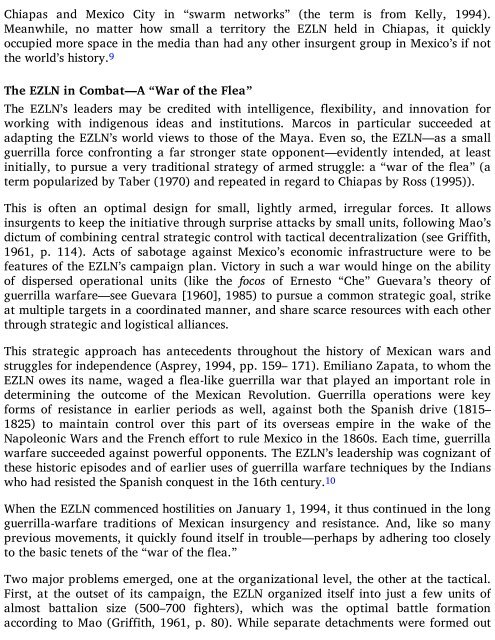RAND_MR1382
Create successful ePaper yourself
Turn your PDF publications into a flip-book with our unique Google optimized e-Paper software.
Chiapas and Mexico City in “swarm networks” (the term is from Kelly, 1994).<br />
Meanwhile, no matter how small a territory the EZLN held in Chiapas, it quickly<br />
occupied more space in the media than had any other insurgent group in Mexico’s if not<br />
the world’s history. 9<br />
The EZLN in Combat—A “War of the Flea”<br />
The EZLN’s leaders may be credited with intelligence, flexibility, and innovation for<br />
working with indigenous ideas and institutions. Marcos in particular succeeded at<br />
adapting the EZLN’s world views to those of the Maya. Even so, the EZLN—as a small<br />
guerrilla force confronting a far stronger state opponent—evidently intended, at least<br />
initially, to pursue a very traditional strategy of armed struggle: a “war of the flea” (a<br />
term popularized by Taber (1970) and repeated in regard to Chiapas by Ross (1995)).<br />
This is often an optimal design for small, lightly armed, irregular forces. It allows<br />
insurgents to keep the initiative through surprise attacks by small units, following Mao’s<br />
dictum of combining central strategic control with tactical decentralization (see Griffith,<br />
1961, p. 114). Acts of sabotage against Mexico’s economic infrastructure were to be<br />
features of the EZLN’s campaign plan. Victory in such a war would hinge on the ability<br />
of dispersed operational units (like the focos of Ernesto “Che” Guevara’s theory of<br />
guerrilla warfare—see Guevara [1960], 1985) to pursue a common strategic goal, strike<br />
at multiple targets in a coordinated manner, and share scarce resources with each other<br />
through strategic and logistical alliances.<br />
This strategic approach has antecedents throughout the history of Mexican wars and<br />
struggles for independence (Asprey, 1994, pp. 159– 171). Emiliano Zapata, to whom the<br />
EZLN owes its name, waged a flea-like guerrilla war that played an important role in<br />
determining the outcome of the Mexican Revolution. Guerrilla operations were key<br />
forms of resistance in earlier periods as well, against both the Spanish drive (1815–<br />
1825) to maintain control over this part of its overseas empire in the wake of the<br />
Napoleonic Wars and the French effort to rule Mexico in the 1860s. Each time, guerrilla<br />
warfare succeeded against powerful opponents. The EZLN’s leadership was cognizant of<br />
these historic episodes and of earlier uses of guerrilla warfare techniques by the Indians<br />
who had resisted the Spanish conquest in the 16th century. 10<br />
When the EZLN commenced hostilities on January 1, 1994, it thus continued in the long<br />
guerrilla-warfare traditions of Mexican insurgency and resistance. And, like so many<br />
previous movements, it quickly found itself in trouble—perhaps by adhering too closely<br />
to the basic tenets of the “war of the flea.”<br />
Two major problems emerged, one at the organizational level, the other at the tactical.<br />
First, at the outset of its campaign, the EZLN organized itself into just a few units of<br />
almost battalion size (500–700 fighters), which was the optimal battle formation<br />
according to Mao (Griffith, 1961, p. 80). While separate detachments were formed out










![Genki - An Integrated Course in Elementary Japanese II [Second Edition] (2011), WITH PDF BOOKMARKS!](https://img.yumpu.com/58322134/1/180x260/genki-an-integrated-course-in-elementary-japanese-ii-second-edition-2011-with-pdf-bookmarks.jpg?quality=85)
![Genki - An Integrated Course in Elementary Japanese I [Second Edition] (2011), WITH PDF BOOKMARKS!](https://img.yumpu.com/58322120/1/182x260/genki-an-integrated-course-in-elementary-japanese-i-second-edition-2011-with-pdf-bookmarks.jpg?quality=85)





